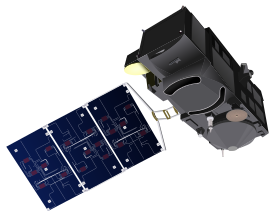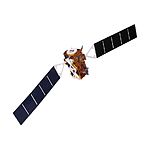cosmos.wikisort.org - Spacecraft
Sentinel-3B is a European Space Agency Earth observation satellite dedicated to oceanography which launched on 25 April 2018.[1] It was built as a part of the Copernicus Programme, and is the second (after Sentinel-3A, launched 16 February 2016) of four planned Sentinel-3 satellites.
 Vector drawing of the Sentinel-3 | |||||||||||||||||
| Mission type | Earth observation | ||||||||||||||||
|---|---|---|---|---|---|---|---|---|---|---|---|---|---|---|---|---|---|
| Operator | ESA · EUMETSAT | ||||||||||||||||
| COSPAR ID | 2018-039A | ||||||||||||||||
| SATCAT no. | 43437 | ||||||||||||||||
| Website | Sentinel-3 (ESA) | ||||||||||||||||
| Mission duration | Planned: 7 years Elapsed: 4 years, 2 months, 9 days | ||||||||||||||||
| Spacecraft properties | |||||||||||||||||
| Spacecraft type | Sentinel-3 | ||||||||||||||||
| Bus | Prima | ||||||||||||||||
| Manufacturer | Thales Alenia Space[1] | ||||||||||||||||
| Launch mass | 1,250 kg (2,756 lb)[2] | ||||||||||||||||
| Dry mass | 1,150 kg (2,535 lb)[3] | ||||||||||||||||
| Dimensions | 3.9 × 2.2 × 2.2 m (12.8 × 7.2 × 7.2 ft)[2] | ||||||||||||||||
| Power | 2,300 watts[3] | ||||||||||||||||
| Start of mission | |||||||||||||||||
| Launch date | 25 April 2018, 17:57:51 UTC[1] | ||||||||||||||||
| Rocket | Rokot | ||||||||||||||||
| Launch site | Plesetsk Cosmodrome, Site 133 | ||||||||||||||||
| Contractor | Eurockot Launch Services | ||||||||||||||||
| Orbital parameters | |||||||||||||||||
| Reference system | Geocentric | ||||||||||||||||
| Regime | Sun-synchronous | ||||||||||||||||
| Semi-major axis | 7,180.77 km (4,461.92 mi) | ||||||||||||||||
| Eccentricity | 0.0001027 | ||||||||||||||||
| Perigee altitude | 801.90 km (498.28 mi) | ||||||||||||||||
| Apogee altitude | 803.38 km (499.20 mi) | ||||||||||||||||
| Inclination | 98.6276° | ||||||||||||||||
| Period | 100.93 min | ||||||||||||||||
| RAAN | 183.84° | ||||||||||||||||
| Argument of perigee | 96.39° | ||||||||||||||||
| Mean motion | 14.26 rev/day | ||||||||||||||||
| Repeat interval | 27 days[4] | ||||||||||||||||
| Epoch | 25 April 2018, 20:50:15 UTC[5] | ||||||||||||||||
| Transponders | |||||||||||||||||
| Band | S band (TT&C support) X band (science data) | ||||||||||||||||
| Bandwidth | S band: 64 kbit/s uplink, 1 Mbit/s downlink X band: 2 × 280 Mbit/s | ||||||||||||||||
| |||||||||||||||||
Sentinel-3 | |||||||||||||||||
Launch
Sentinel-3B was successfully launched on 25 April 2018 at 17:57 UTC from the Plesetsk Cosmodrome aboard a Rokot launch vehicle.[1]
See also
- Sentinel-3#Instruments
References
- Clark, Stephen (25 April 2018). "European environmental observer launched by Russian rocket". Spaceflight Now. Retrieved 25 April 2018.
- "Copernicus: Sentinel-3". eoPortal. European Space Agency. Retrieved 25 April 2018.
- "Satellite: Sentinel-3B". World Meteorological Organization. Retrieved 25 April 2018.
- "Sentinel-3 › Mission Summary". European Space Agency. Retrieved 30 January 2016.
- "Sentinel 3B - Orbit". Heavens Above. 25 April 2018. Retrieved 25 April 2018.
External links
- Sentinel-3 program website by ESA
- Sentinel-3 website by the Copernicus Programme
- Real-time orbital tracking - uphere.space
Текст в блоке "Читать" взят с сайта "Википедия" и доступен по лицензии Creative Commons Attribution-ShareAlike; в отдельных случаях могут действовать дополнительные условия.
Другой контент может иметь иную лицензию. Перед использованием материалов сайта WikiSort.org внимательно изучите правила лицензирования конкретных элементов наполнения сайта.
Другой контент может иметь иную лицензию. Перед использованием материалов сайта WikiSort.org внимательно изучите правила лицензирования конкретных элементов наполнения сайта.
2019-2025
WikiSort.org - проект по пересортировке и дополнению контента Википедии
WikiSort.org - проект по пересортировке и дополнению контента Википедии

